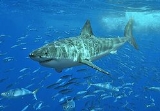
Chondrichthyes
Overview
Fish
Fish are a paraphyletic group of organisms that consist of all gill-bearing aquatic vertebrate animals that lack limbs with digits. Included in this definition are the living hagfish, lampreys, and cartilaginous and bony fish, as well as various extinct related groups...
with paired fins, paired nares, scales, two-chambered hearts, and skeletons made of cartilage
Cartilage
Cartilage is a flexible connective tissue found in many areas in the bodies of humans and other animals, including the joints between bones, the rib cage, the ear, the nose, the elbow, the knee, the ankle, the bronchial tubes and the intervertebral discs...
rather than bone
Bone
Bones are rigid organs that constitute part of the endoskeleton of vertebrates. They support, and protect the various organs of the body, produce red and white blood cells and store minerals. Bone tissue is a type of dense connective tissue...
. The class is divided into two subclasses: Elasmobranchii
Elasmobranchii
Elasmobranchii is a subclass of Chondrichthyes or cartilaginous fish, that includes the sharks and the rays and skates .-Evolution:...
(shark
Shark
Sharks are a type of fish with a full cartilaginous skeleton and a highly streamlined body. The earliest known sharks date from more than 420 million years ago....
s, ray
Batoidea
Batoidea is a superorder of cartilaginous fish commonly known as rays and skates, containing more than 500 described species in thirteen families...
s and skate
Skate
Skates are cartilaginous fish belonging to the family Rajidae in the superorder Batoidea of rays. There are more than 200 described species in 27 genera. There are two subfamilies, Rajinae and Arhynchobatinae ....
s) and Holocephali
Holocephali
The subclass Holocephali is a taxon of cartilaginous fish, of which the order Chimaeriformes is the only surviving group.Holocephali has an extensive fossil record that starts during the Devonian period. However, most fossils are teeth, and the body forms of numerous species are not known, or, at...
(chimaera
Chimaera
Chimaeras are cartilaginous fish in the order Chimaeriformes, known informally as ghost sharks, ratfish , spookfish , or rabbitfishes...
s, sometimes called ghost sharks, which are sometimes separated into their own class).
Within the infraphylum Gnathostomata
Gnathostomata
Gnathostomata is the group of vertebrates with jaws. The term derives from Greek γνάθος "jaw" + στόμα "mouth". Gnathostome diversity comprises roughly 60,000 species, which accounts for 99% of all living vertebrates...
, cartilaginous fishes are distinct from all other jawed vertebrates, the extant members of which all fall into Teleostomi
Teleostomi
Teleostomi is a clade of jawed vertebrates that includes the tetrapods, bony fish, and the wholly extinct acanthodian fish. Key characters of this group include an operculum and a single pair of respiratory openings, features which were lost or modified in some later representatives...
.
The skeleton is cartilaginous.
Discussions

